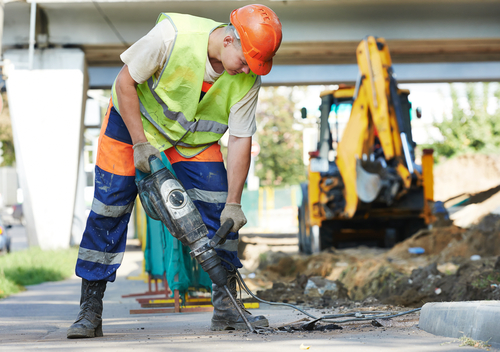Pneumatic power tools such as nail guns, chippers, drills, hammers, and sanders are found not only in the workplace but also in the hands of many consumers—and not all of them are construction workers who use those tools during their day jobs and receive appropriate training. Make sure that not only your tradesmen but also your “weekend warriors” are aware of the potential hazards of these powered hand tools.

Pneumatic power tools such as nail guns, chippers, drills, hammers, and sanders are found not only in the workplace but also in the hands of many consumers—and not all of them are construction workers who use those tools during their day jobs and receive appropriate training. Make sure that not only your tradesmen but also your “weekend warriors” are aware of the potential hazards of these powered hand tools.
Pneumatic Injuries
Workers can be directly injured by pneumatic power tools when:
- Attachments or fasteners are not secured properly and fly off the tool. To control this hazard, make sure your pneumatic impact tools to have safety clips or retainers that prevent dies and tools from being accidentally expelled from the barrel.
- The operator misses the intended surface, and a nail or staple strikes a bystander. To prevent this from happening, make sure all handheld pneumatically powered tools used for driving nails, staples, and similar fasteners that operate at 100 psig (pound-force per square-inch gauge) or more line pressure are equipped with a safety device that prevents the tool from operating unless the muzzle is in contact with a surface.
Think you have no time to train? Think again. BLR’s 7-Minute Safety Trainer helps you fulfill key OSHA-required training tasks in as little as 7 minutes. Try it at no cost and see!
- Hoses are accidentally disconnected from the tools. An unconnected high-pressure hose is a flogging hazard to workers in the area. To prevent this, make sure that all hose connections on pneumatic power tools, including the one at the tool, are secured by a positive locking device to prevent accidental disconnection. Alternately, a ball check device or equivalent can be provided at the air source.
- Hoses fail. As when pressurized hoses become disconnected, a hose that fails can whip around wildly, creating a hazard. To prevent damage to hoses, make sure that the manufacturer’s safe operating pressures for hoses, pipes, valves, filters, and other fittings are not exceeded. Also, make sure that hoses with greater than a half-inch inside diameter have a safety device to reduce pressure in case of hose failure. Hoses must not be used to lift or lower tools.
- Tools are accidentally activated. Workers may trip on air hoses or in some other fashion accidentally activate pneumatic tools. For this reason, pneumatic nailers and staplers must be disconnected from their air supply at the tool when not in use or unattended.
Effective, 7-minute sessions providing comprehensive safety training at an average cost of $1 a day. Get the details.
Additional Hazards
Pneumatic powered hand tools also pose more general sorts of hazards, including:
- Noise. Pneumatic tools can easily generate noise in excess of the permissible exposure level. Be sure workers are participating in a hearing protection program if necessary.
- Flying objects. Pneumatic tools can create flying object hazards, so operators should have eye, face, and head protection. Bystanders can be protected with personal protective equipment or screens.
- Ergonomics. Vibration, awkward postures, and forceful and repeated exertions may all be associated with using these tools, so assess and address ergonomic hazards.
Tomorrow, we’ll look at a specific type of pneumatic power tool that can be extremely hazardous—nail guns.
